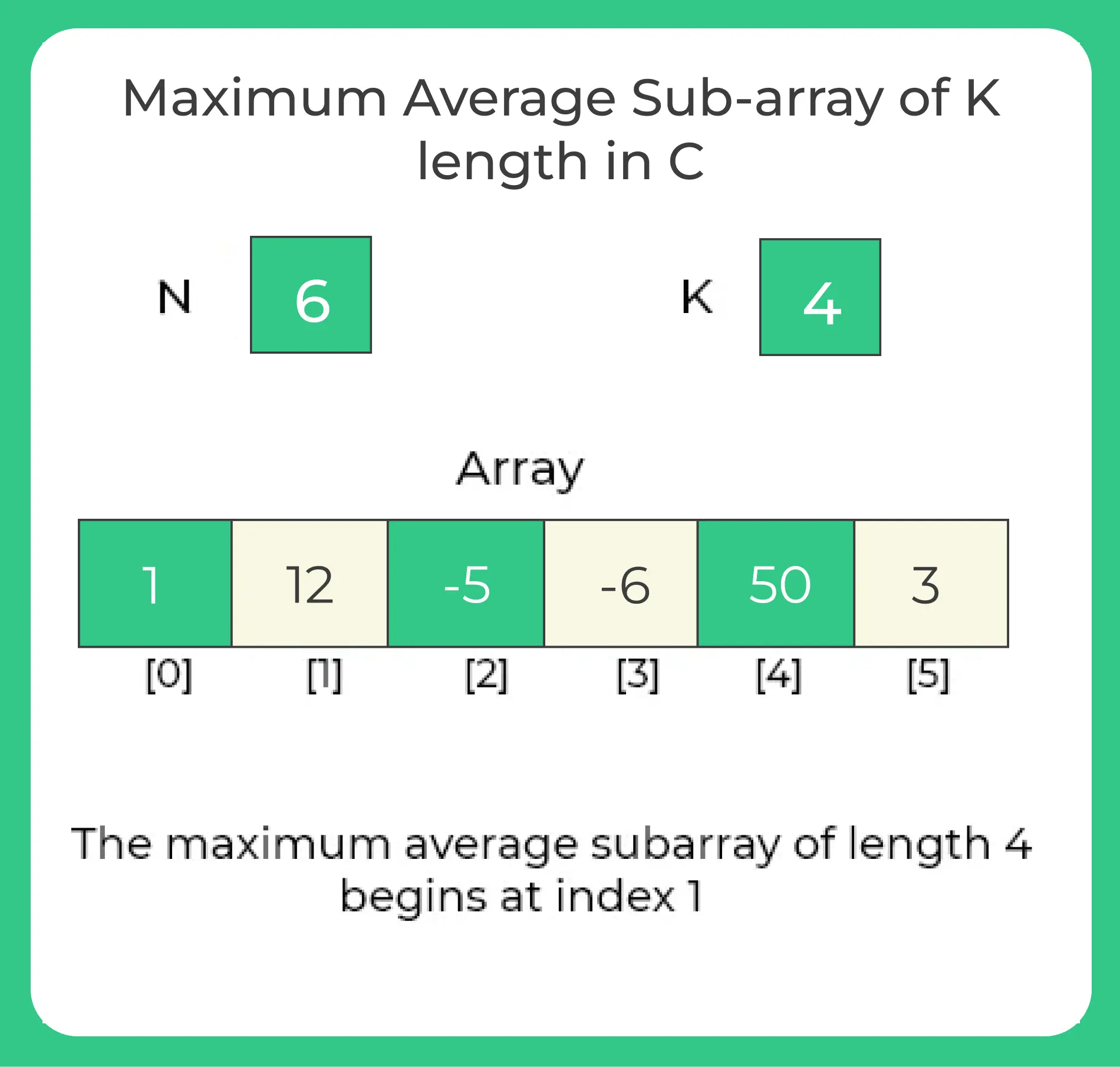0
Notifications Mark All Read
- Login
- Get Prime
Maximum Average Sub-array of K length in C
Maximum Average Sub-array of K length
On this page we will discuss about maxium average sub-array of K length in C language . we are given with a sequence of N integers, a[1], a[2], , , , a[N] of N length and a integer K integer.
We have to Find out the maximum possible average value of sub-array of K length.

Maximum Average Sub-array of K length in C
The maximum average subarray of length k refers to a contiguous subarray of length k within a given array of numbers, whose average is maximum among all possible subarrays of length k in that array. In other words, it is the subarray of k consecutive elements whose sum is the largest possible among all subarrays of k consecutive elements in the array.
For example,consider the array
[1, 12, -5, -6, 50, 3] and k=4.
The subarrays of length 4 are [1, 12, -5, -6], [12, -5, -6, 50], [-5, -6, 50, 3], and their averages are 0.5, 12.75, and 10.5 respectively. The maximum average subarray of length 4 in this case is [12, -5, -6, 50], whose average is 12.75.

Algorithm:
Create an auxiliary array of size n.
Store cumulative sum of elements in this array.
Let’s the array be csum[]. csum[i] stores sum of elements from arr[0] to arr[i].
Once we have csum[] array with us, we can compute sum between two indexes.
C code for maximum average sub-array of k length
#include<stdio.h>
int findMaxAverage (int arr[], int n, int k)
{
if (k > n)
return -1;
int *csum = arr;
csum[0] = arr[0];
for (int i = 1; i < n; i++)
csum[i] = csum[i - 1] + arr[i];
int max_sum = csum[k - 1], max_end = k - 1;
for (int i = k; i < n; i++)
{
int curr_sum = csum[i] - csum[i - k];
if (curr_sum > max_sum)
{
max_sum = curr_sum;
max_end = i;
}
}
return max_end - k + 1;
}
int main ()
{
int arr[] = { -1, 10, -15, -6, 50, 3 };
int k = 4;
int n = sizeof (arr) / sizeof (arr[0]);
printf ("The maximum average subarray of length %d begins at index %d", k,
findMaxAverage (arr, n, k));
return 0;
}
Output
The maximum average subarray of length 4 begins at index 1
Prime Course Trailer
Related Banners
Get PrepInsta Prime & get Access to all 200+ courses offered by PrepInsta in One Subscription
Get over 200+ course One Subscription
Courses like AI/ML, Cloud Computing, Ethical Hacking, C, C++, Java, Python, DSA (All Languages), Competitive Coding (All Languages), TCS, Infosys, Wipro, Amazon, DBMS, SQL and others
Introduction to Trees
Binary Trees
- Binary Tree in Data Structures (Introduction)
- Tree Traversals: Inorder Postorder Preorder : C | C++ | Java
- Inorder Postorder PreOrder Traversals Examples
- Tree Traversal without Recursion
Binary Search Trees
Traversals
- Traversal in Trees
- Tree Traversals: Breadth-First Search (BFS) : C | C++ | Java
- Tree Traversals: Depth First Search (DFS) : C | C++ | Java
- Construct a Binary Tree from Postorder and Inorder
B – Trees
AVL Trees
- AVL Trees
Complete Programs for Trees
- Depth First Traversals – C | C++ | Java
- Level Order Traversal – C | C++ | Java
- Construct Tree from given Inorder and Preorder traversals – C | C++ | Java
- Construct Tree from given Postorder and Inorder traversals – C | C++ | Java
- Construct Tree from given Postorder and Preorder traversal – C | C++ | Java
- Find size of the Binary tree – C | C++ | Java
- Find the height of binary tree – C | C++ | Java
- Find maximum in binary tree – C | C++ | Java
- Check whether two tree are identical- C| C++| Java
- Spiral Order traversal of Tree- C | C++| Java
- Level Order Traversal Line by Line – C | C++| Java
- Hand shaking lemma and some Impotant Tree Properties.
- Check If binary tree if Foldable or not.- C| C++| Java
- check whether tree is Symmetric – C| C++| Java.
- Check for Children-Sum in Binary Tree- C|C++| Java
- Sum of all nodes in Binary Tree- C | C++ | Java
- Lowest Common Ancestor in Binary Tree- C | C++ | Java
Introduction to Trees
Binary Trees
- Binary Tree in Data Structures (Introduction)
- Tree Traversals: Inorder Postorder Preorder : C | C++ | Java
- Inorder Postorder PreOrder Traversals Examples
- Tree Traversal without Recursion
Binary Search Trees
Traversals
- Traversal in Trees
- Tree Traversals: Breadth-First Search (BFS) : C | C++ | Java
- Tree Traversals: Depth First Search (DFS) : C | C++ | Java
- Construct a Binary Tree from Postorder and Inorder
B – Trees
AVL Trees
- AVL Trees
Complete Programs for Trees
- Depth First Traversals – C | C++ | Java
- Level Order Traversal – C | C++ | Java
- Construct Tree from given Inorder and Preorder traversals – C | C++ | Java
- Construct Tree from given Postorder and Inorder traversals – C | C++ | Java
- Construct Tree from given Postorder and Preorder traversal – C | C++ | Java
- Find size of the Binary tree – C | C++ | Java
- Find the height of binary tree – C | C++ | Java
- Find maximum in binary tree – C | C++ | Java
- Check whether two tree are identical- C| C++| Java
- Spiral Order traversal of Tree- C | C++| Java
- Level Order Traversal LIne by Line – C | C++| Java
- Hand shaking lemma and some Impotant Tree Properties.
- Check If binary tree if Foldable or not.- C| C++| Java
- check whether tree is Symmetric C| C++| Java.
- Check for Children-Sum in Binary Tree- C|C++| Java
- Sum of all nodes in Binary Tree- C | C++ | Java
- Lowest Common Ancestor in Binary Tree. C | C++ | Java

 0
0



Login/Signup to comment